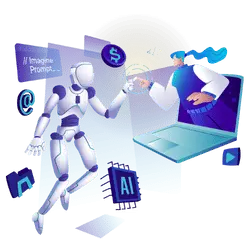
Artificial intelligence is the term used to refer to a technologies that allow digital robots or computers to carry out tasks that are like intelligent creatures. AI systems are developed to imitate human cognitive processes including reasoning, finding the meaning of things, together generalization, as well as learning from previous experiences. Computers have been designed to complete extremely complex tasks that require high-performance from the 1940s (e.g. the demonstration of mathematical theorems, or playing Chess). While modern computers are far superior to the 1950s models, none of these AI programs have yet matched human capabilities across more broader areas as well as tasks that require a lot of understanding of the daily. A few AI programs have reached human-like performance in certain jobs, assisting in a variety of areas like the diagnosis of medical problems and searches and handwriting or voice recognition and chatbots.
How AI is Used in Everyday Life
Artificial Intelligence has come a far way, and it is transforming businesses by changing the horizon of operational practices and procedures. Although AI was in use since the 1950s, current applications are revolutionizing. Here are just a few methods AI has expanded its reach in everyday tasks:
Taxi Booking Apps
AI-powered ride-hailing services such as Uber analyze historical data to definitely allocate drivers and anticipate the patterns of demand. Modern algorithms benefit optimize allocation of drivers to regions with the highest demand, which outcome in faster responses. AI is useful in designing routes with machine learning techniques to analyse real-time transportation data, which includes road closures, as well as other factors that can benefit travelers arrive quicker.
Voice Assistants
Digital assistants such as Siri, Google Home, and Alexa make use of AI-powered voice User Interfaces (VUI) to translate commands with natural spoken language. They access huge databases on cloud platforms, and process huge quantities of information to attain jobs as well as deliver specific results. outcome rapidly. Voice assistants in healthcare recognize diseases through voice biomarkers, and also support the use of telehealth for the triage of patients and for screening.
Chatbots
Chatbots are evolving from the basic rules-based platforms to more sophisticated conversational agents such as ChatGPT. With the benefit of natural processing of language (NLP) as well as machine-learning, chatbots have the ability to respond to user inquiries more efficiently and prepare relevant answers. Chatbots are integrated into apps and websites, enabling 24 hours a day customer service, and boost customer satisfaction by analyzing sentiment.
Entertainment Streaming Apps
The machine learning algorithm is employed by the streaming service providers such as Netflix, Spotify, and Hulu to analyze user behaviour and recommend certain material. AI filters through the records to customize the music, movies and TV series libraries. It ensures seamless streaming through the distribution of servers to the most popular content and by increasing bandwidth when required.
Personalized Marketing
Companies employ AI-driven tools to personalize their interactions with their customers definitely. AI examines data from customers to customize marketing email campaigns, emails and even recommendations to rise customer satisfaction as well as the number of conversions. Innovative techniques include the ability to predict ad performance with computer vision as well as creating logos that are appealing to target people.
Google Lens
Google Lens, based on AI can detect landmarks, objects and even text by using photographs. Google Lens makes use of Optical Character Recognition (OCR) to read and alter text. It also allows features like scanning foreign signage or recording business card information as contacts.
Social Media Algorithms
Platforms such as Instagram, Facebook, and YouTube utilize AI algorithms to tailor user experience. They track user behaviors in order to design material feeds, suggest connections, and even place relevant ads. Machine learning models can also benefit in the policing of platforms and remove unsuitable material.
Smart Input Keyboards
The AI-powered keyboard applications for mobile devices implement advanced autocorrection technology, languages detection, as well as predictive functions for typing to increase the users’ experience. They support more than 300 languages and dialects together machines learning algorithms that detect context and predict phrases.
Fraud Detection in Banking
AI systems in banks can detect and deter fraudulent activity by identifying suspicious behavior and patterns in transactions that could indicate fraud or suspicious activity.
Navigation and Travel
Applications for travel like Google Maps use AI to study real-time traffic data and improve routes to make it easier for travelers. AI-driven models increase the accuracy of routes and are updated with satellite imagery as well as geographical information.
Gamified Therapy
AI-powered gaming applications monitor players their mental state and bring beneficial therapeutic effects. Virtual virtual reality (VR) headsets rise the level of engagement during cognitive behavior therapy (CBT) by adapting the game to users’ behaviors.
Wearables and AI in Cars
Wearables make use of AI algorithms to recognize accidents and track driving habits in the event of collisions. AI technology in automobiles improves security by analysing the surrounding environment, anticipating risk as well as improving the safety of roads.
Self-Driving Vehicles
AI advances allow autonomous vehicles to work autonomously together deep reinforcement as well as simultaneously localization and map (SLAM). These vehicles can traverse surroundings, anticipate hazards, and increase the safety of roads.
Facial Recognition Technologies
Face recognition technology on phones and security systems utilizes AI to open devices and improve security. AI decreases bias and increases precision in facial recognition software. It is essential in a variety of applications.
AI-Driven Speech Recognition
AI improves speech recognition apps like Google Recorder and Live Captions by transforming spoken words to the form of text on screen. These functions improve interaction with multimedia material interaction and encourage engagement.
Worker Health & Safety
Security and health of workers is vital in the industrial or factories. AI systems for monitoring video analyze surveillance footage in order to spot unusual behavior, and increase the security of people.
Email Filtering
AI-powered filtering of emails can identify the spam emails, files into folders and improve collaboration with automated text-to-text typing as well as autocorrect functions.
AI Image Generators
Generative AI models, such as DALL E, create visual images using texts, enabling innovative design as well as visual material creation across different industries.
Weather Prediction
AI-powered models for weather forecasting analyze both the present and future weather data in the planning of daily activities.
Internet of Things (IoT)
AI can enhance IoT devices through studying and analysing the data from sensors in real-time to respond or act according to human behavior. AI enables more intelligent appliances for homes and automating jobs.
In simple terms, AI is a part in almost all aspects of our lives that improves efficiency, comfort and individualization. As AI technology improves and its applications grow, they will increase, creating new businesses and improving living standards.


